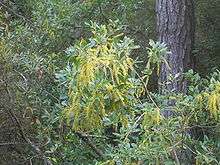Luquillo Experimental Forest
The Luquillo Experimental Forest is a protected area of tropical rainforest in northeastern Puerto Rico. The experimental forest is located in the Sierra de Luquillo some 50 km (30 mi) east of San Juan, the capital of the island. It is a UNESCO Biosphere Reserve and is used for research into silviculture, forest regeneration, and other purposes.
History
The Tropical Forest Research Station was founded in 1940 and became a centre for ecosystem research.[1] It was designated as a UNESCO Biosphere Reserve in 1976 with the objective of understanding "the long-term dynamics of tropical forest ecosystems characterized by large-scale, infrequent disturbance, rapid processing of organic material, and high habitat and species diversity".[2]
Although the experimental forest is located within the Caribbean National Forest, the two have different objectives. In a forest management plan drawn up in 1956, approximately 6,700 hectares (17,000 acres) were to be used for commercial timber production, mostly the lower, flatter part of the site. The remaining 4,630 hectares (11,400 acres), largely mountain peaks and steep slopes, were considered non-commercial and were set aside for research and other purposes. Much of the experimental area is used for silviculture and reforestation research, but one particular area, "Baño de Oro" has been left completely unmanaged and undisturbed, for use in long term ecological studies.[3]
The experimental forest is one of 26 sites run by the Long Term Ecological Research Network, a group of international scientists studying ecological processes over long time scales.[4] The facility was established in 1988 to study the "long-term effects of natural and human disturbances on tropical forests and streams in the Luquillo Mountains". The aspects studied include how hurricanes and droughts have affected the environment, and the effects of changes in agricultural practices and increased urbanization. A central database is maintained, collaboration between scientists, students and volunteers is encouraged, and efforts are made to involve the local community.[5]
The Luquillo Mountains
The Luquillo Mountains are about 1,000 m (3,300 ft) high with steep, convoluted slopes. Trade winds off the Atlantic Ocean cool as they rise over the mountains, bringing an annual rainfall of 5,000 mm (200 in). The mountains are well-forested and are clad in mist for most of the year. The Luquillo Experimental Forest has an area of about 11,000 hectares (27,000 acres) and encompasses five different vegetation zones; montane wet forest, montane rainforest, wet forest, rainforest, and a small area of moist forest in the southwestern part.[6] The experimental forest site is wholly inside the El Yunque National Forest, which covers a large part of the mountain range to the southwest of the city of Luquillo.[7]

The composition of the forest varies according to the elevation, soil types and other factors.[8] Compared to most mainland forests the site has a low floral biodiversity; for example, only eight species of tree account for 75% of tree density.[9] The lower parts are dominated by the candlewood tree (Dacryodes excelsa), and the middle slopes by the titi (Cyrilla racemiflora). The upper slopes, with their perpetual cloud cover, poor light and permanently saturated soils, are clad with trees of low stature and are known as dwarf forest.[6] The trees here include Weinmannia pinnata, Prestoea montana, Brunellia comocladifolia and Podocarpus coriaceus.[8]
Research
Over 2,500 research studies having been performed in the Luquillo Experimental Forest.[1] One area of research is the resilience of the ecosystem in the face of hurricanes, landslides, and such long term changes as alterations in agricultural practices and use.[1] A study in 2018 compared the biomass of animals collected in the forest with data from the 1970s and found a large decline, which the authors attributed to global warming,[10] although the conclusions were disputed by a larger group of researchers working in the area, who were unable to replicate most of the findings, including the temperature change.[11]
References
- Wade, Bob (1997). "Luquillo Experimental Forest". LTER Network News. 20 (1).
- "Biosphere Reserve Information: Luquillo". UNESCO. Retrieved 28 March 2019.
- Brown, S.; Lugo, A.E.; Silander, Susan; Liegel, Leon. (Eds.) (September 1983). "Research History and Opportunities in the Luquillo Experimental Forest" (PDF). USDA, US Forest Service. Retrieved 28 March 2019.CS1 maint: multiple names: authors list (link) CS1 maint: extra text: authors list (link)
- "Puerto Rico: Environmental Research at Luquillo Experimental Forest". LTER. Retrieved 27 March 2019.
- "Luquillo Long-Term Ecological Research (LTER) Program". Retrieved 27 March 2019.
- Harris, N.L.; Lugo, A.E.; Brown, S.; Heartsill Scalley, T. (Eds.) (May 2012). "Luquillo Experimental Forest: Research History and Opportunities" (PDF). USDA, US Forest Service. Retrieved 26 March 2019.CS1 maint: multiple names: authors list (link) CS1 maint: extra text: authors list (link)
- "Luquillo Mountains, Puerto Rico". Earth Observatory. NASA. Retrieved 27 March 2019.
- Gannon, Michael R.; Kurta, Allen; Rodriguez-Duran, Armando (2005). Bats of Puerto Rico: An Island Focus and a Caribbean Perspective. Texas Tech University Press. p. 16. ISBN 978-0-89672-551-5.
- Schall, JJ; Pearson, AR; Perkins, SL (2000). "Prevalence of malaria parasites (Plasmodium floridense and Plasmodium azurophilum) infecting a Puerto Rican lizard (Anolis gundlachi): a nine-year study". J. Parasitol. 86 (3): 511–515. doi:10.2307/3284865.
- Lister, Bradford C.; Garcia, Andres (October 2018), "Climate-driven declines in arthropod abundance restructure a rainforest food web", Proceedings of the National Academy of Sciences, 115 (44): E10397–E10406, doi:10.1073/pnas.1722477115, PMC 6217376, PMID 30322922
- Willig, M. R.; Woolbright, L.; Presley, S. J.; Schowalter, T. D.; Waide, R. B.; Heartsill Scalley, T.; Zimmerman, J. K.; González, G.; Lugo, A. E. (29 May 2019). "Populations are not declining and food webs are not collapsing at the Luquillo Experimental Forest". Proceedings of the National Academy of Sciences of the United States of America. 116 (25): 12143–12144. doi:10.1073/pnas.1820456116. Retrieved 9 September 2019.